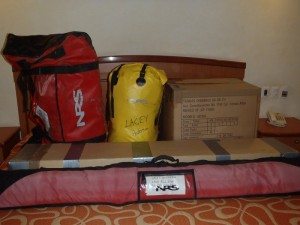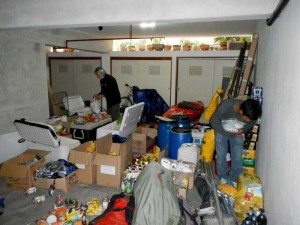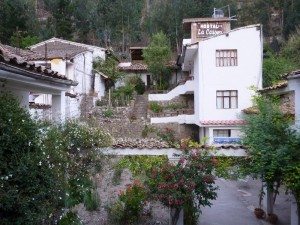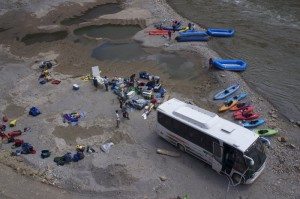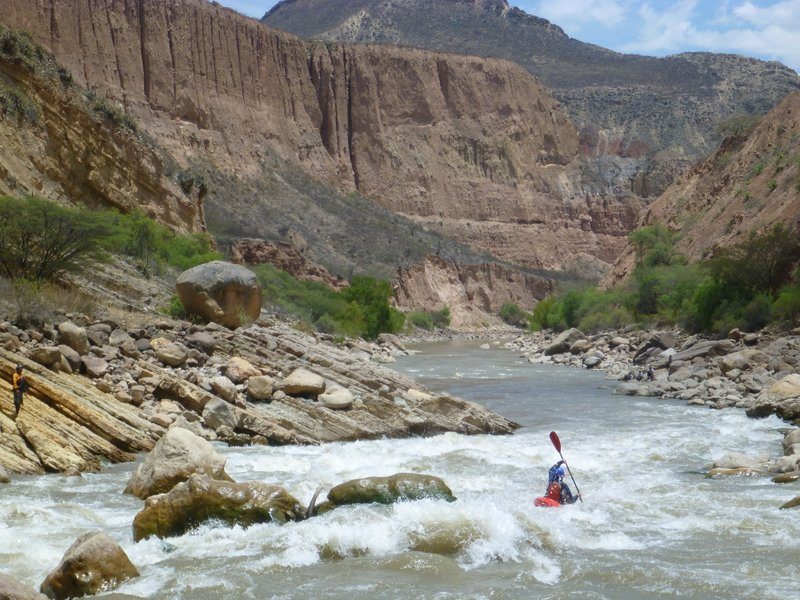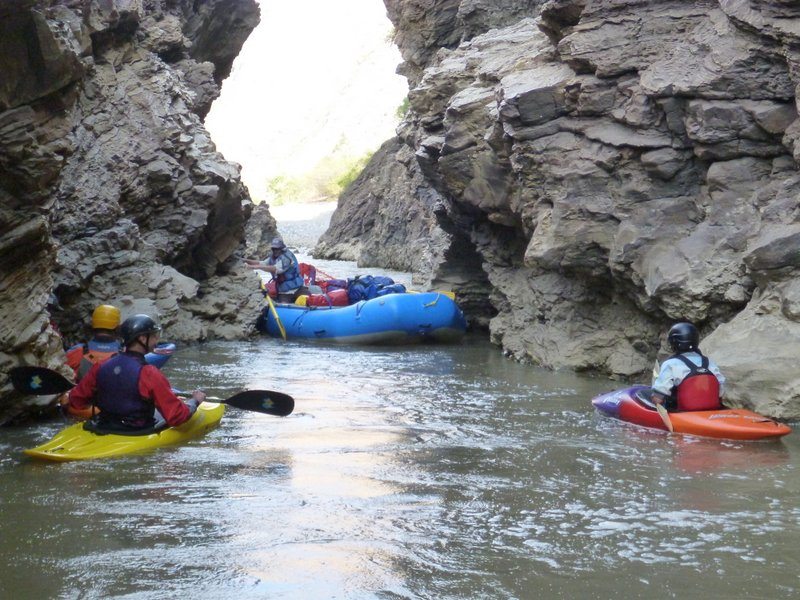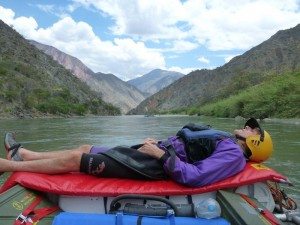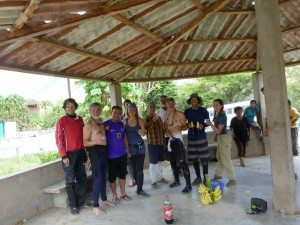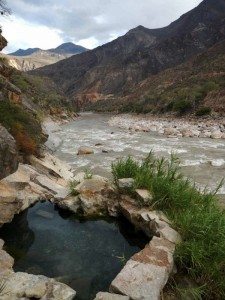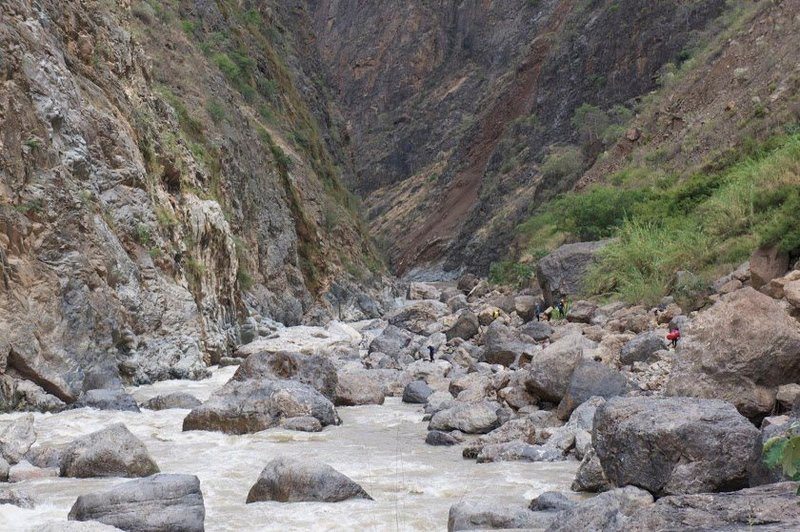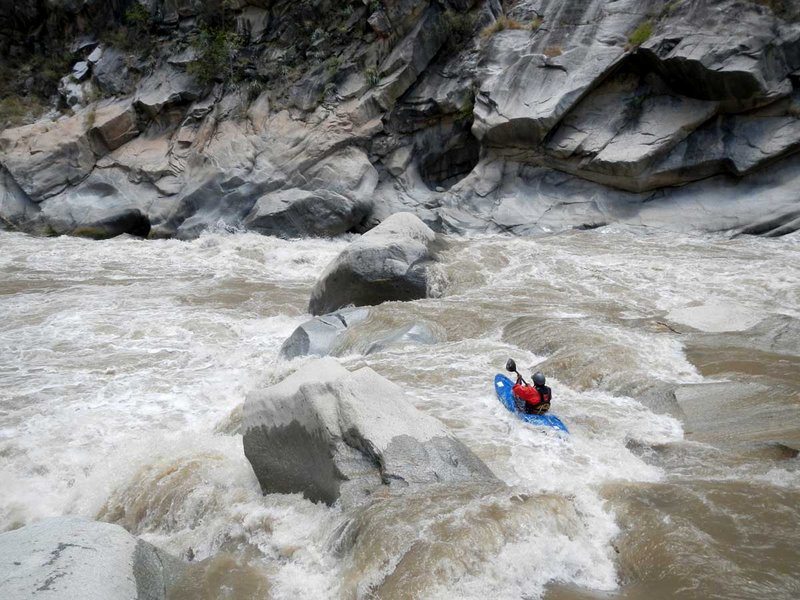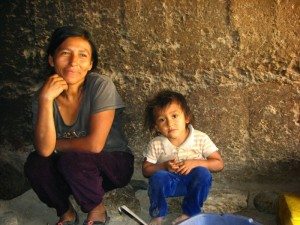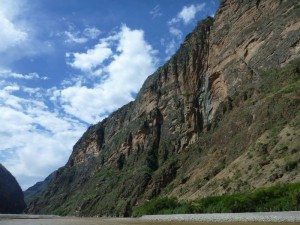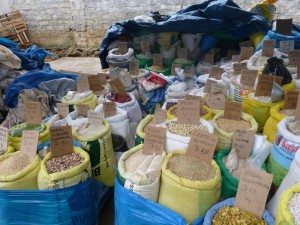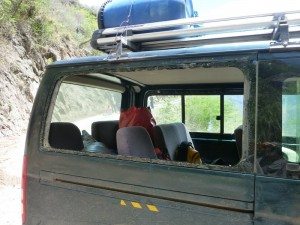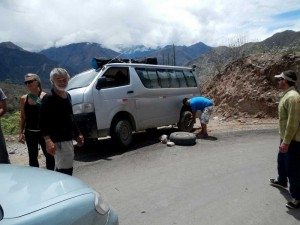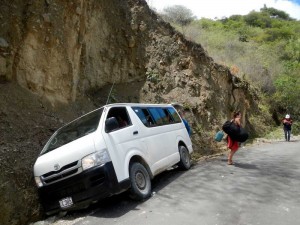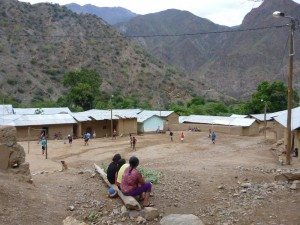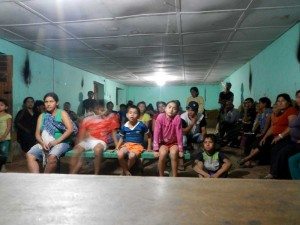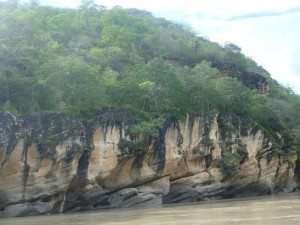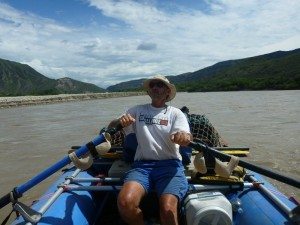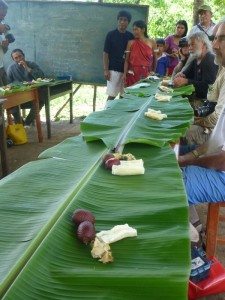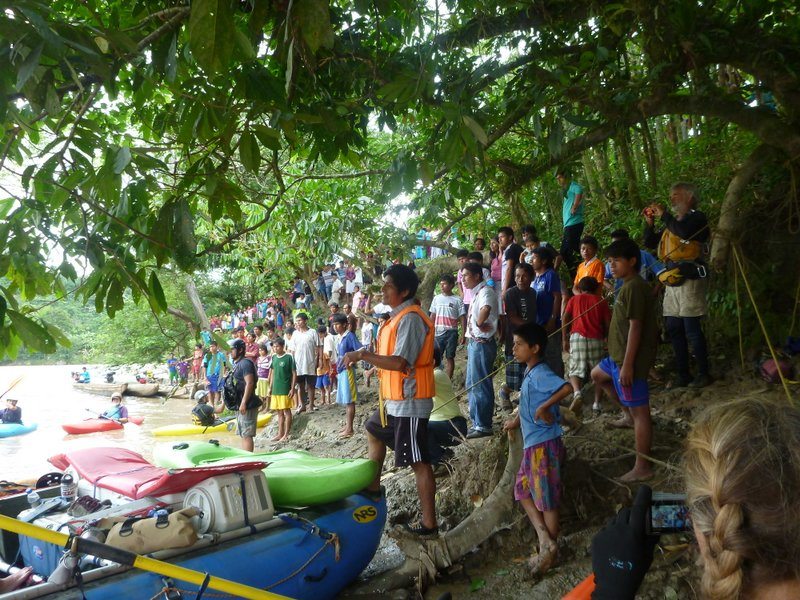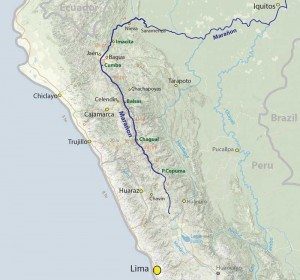 Relaxing at Friend’s House, a hostel in Lima, Peru after completing a 29-day rafting/kayaking adventure down the Rio Maranon organized by Rocky Contos of Sierra Rios. I have accompanied Rocky on a number of trips in the past in Mexico, both as cost-shared exploratory trips and similar “conservation” trips with other passengers contributing through Sierra Rios. This trip was being run to raise more awareness of the dams planned for the Upper Amazon, specifically the Rio Maranon, and to generate revenue for future conservation campaigns. Everyone joining the trip was expected to have an interest in river conservation and help Sierra Rios to document the river further, talk to residents, publicize the issue, and help train local guides.
Relaxing at Friend’s House, a hostel in Lima, Peru after completing a 29-day rafting/kayaking adventure down the Rio Maranon organized by Rocky Contos of Sierra Rios. I have accompanied Rocky on a number of trips in the past in Mexico, both as cost-shared exploratory trips and similar “conservation” trips with other passengers contributing through Sierra Rios. This trip was being run to raise more awareness of the dams planned for the Upper Amazon, specifically the Rio Maranon, and to generate revenue for future conservation campaigns. Everyone joining the trip was expected to have an interest in river conservation and help Sierra Rios to document the river further, talk to residents, publicize the issue, and help train local guides.
This trip was advertised as the “finest raft support trip in South America” down the “Grand Canyon of the Amazon.” The upper portion of the trip from downstream of the confluence with the Rio Puchka to the village of Balsas covered 357 km (221 miles) over the course of 14 days. This section is described as class III-IV, equivalent in difficulty to the Colorado through Grand Canyon, Middle Fork-Main Salmon, Sun Kosi, or Zanskar. The two toughest rapids (Wasson’s Landslide and Llamara) are said to be class V at some flows. There was a re-supply in Celendin/Cajamarca (transport from Balsas) that took 2 days. The lower portion of the trip from Balsas to Imacita covered 307 km (190 miles) over the course of 13 days. This section is described as having a total of around 35 class III and 9 class IV rapids including a final jungle section with 15 big-water rapids (pongos) rated class III-IV.
Lacey and I arrived in Lima a few days prior to the trip as she was scheduled to plan, shop for, and organize several days of food for the trip. There would be little ice available, so her No Coolers philosophy using some foods brought from the USA and locally sourced non-perishable items was perfect for a trip like this. We spent a lot of our first day in Lima checking out the stores to see what kinds of foods are available locally. The second day, Lacey was busy planning her days of food, creating a menu and making a shopping list. She spent the better part of another day running around Lima shopping for the food she would take on the trip.
Each day, trip participants continued to arrive sporadically and meet us at Friends House. Before arriving, we knew our friend Boris would also be on the trip. It turned out that besides Boris and Lacey, I actually knew another of the participants, having boated with John years ago while paddling a bunch with Gold Country Paddlers in California. Peter, who joined us a few days later in the trip, was also an acquaintance from a trip down the Illinois River in Oregon. Small world! We are a group of 19 people including Pedro and Julio, two Peruvians serving as assistant guides for the trip.
One of the other participants, Chris, who was living in Lima, had offered his garage to stage some of the equipment and organize the food. After the big food shop, Boris was instrumental in organizing and packing the coolers and food barrels for the trip. Few of the other participants knew how much Lacey and Boris did behind the scenes to get the trip started on the right track. Pedro was also busy running around town finding group gear like propane tanks, stoves, cooking pots, etc.
The first day of the actual trip, there is semi-organized chaos getting the gear and everyone into the bus. By the time initial group pictures are taken, it was around 9:00. We then drove through Lima traffic towards the airport where we met Rocky after he arranged for return of his rental car. Luckily it was on the way to the river and we were on the road for good around 10:30! The 8-hour bus ride turned out to be about 11 hours and we stopped in Chavin for the night.
The next morning there is more group gear to be located and purchased for the trip and then we are off for another 4.5 hour drive to the river. This was a pretty drive through the canyon and along the Rio Puchka and then down the Rio Maranon to a put-in on private land at a gravel mining operation. Some of the participants jumped in with little direction and begin inflating the boats and assembling the frames. Thanks guys! A few of the kayakers rode the bus back to the bridge over the Maranon and paddled the few kilometers down from there. Things were all topped off and frames strapped on by dinner time. We camped at the put-in, anticipating a good day of boating en la manana.
In the morning it is time to load the boats. Confusion reigns about which coolers go where, who is carrying what, and how to strap it all on! Most of the group is pretty experienced, so things get sorted out and all of the gear loaded by late morning. I am rowing the 16-foot NRS cataraft which has lost air in one tube overnight. Oh well, top off and hope for the best. Rocky says the flow should be around 2,000 cfs but I think it is more like 1,500 cfs. This is relatively low for this river as we are running just ahead of the rainy season.
Just downstream at the first rapid (Class III), we are signaled to take the center channel. I misjudge the current and weight of the raft and get stuck on a rock for a few minutes. A bit of tugging and lifting and Lou-Phi (my passenger for the day) and I are off. The rest of the boats take a slightly different line with much better results. The next significant rapid (Class IV) requires a hard ferry to avoid a pour-over rock. Not sure that I can make the pull, I have Rocky row the big cat through so I wouldn´t be responsible if anything happens! Boris takes a “hero” line into a big hole and swims briefly.
Later that day we reach “the narrows” in a limestone gorge where the passage is about 8 feet wide. Luckily there is little current and everyone slides through easily, even the big NRS cat that has a few inches clearance on either side. We camp downstream on a huge sandbar where the wind sandblasts us for a while.
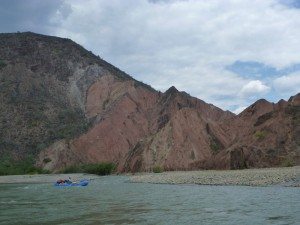 The next day we pass through a colorful section of the canyon with lots of red and orange rock walls. We have gained a bit of water (500 cfs?) from several tributaries. Lou-Phi tries his hand at kayaking and ends up swimming a minor rapid. Luckily I am right behind him to rescue him as most of the kayakers are well out in front. There are a few Class III rapids today and a III+ that we all run fine without scouting. After a short hike through a mini-slot to a waterfall, we continue downstream, pull into camp late and eat much later around 8:30.
The next day we pass through a colorful section of the canyon with lots of red and orange rock walls. We have gained a bit of water (500 cfs?) from several tributaries. Lou-Phi tries his hand at kayaking and ends up swimming a minor rapid. Luckily I am right behind him to rescue him as most of the kayakers are well out in front. There are a few Class III rapids today and a III+ that we all run fine without scouting. After a short hike through a mini-slot to a waterfall, we continue downstream, pull into camp late and eat much later around 8:30.
Several people are sick with intestinal problems in the morning: I suspect the water or perhaps the coleslaw from last night´s dinner. Some are sick enough they don´t want to paddle and end up riding on the rafts. We start off with a couple of Class III´s and it is pretty mellow for much of the day. Then wham! a Class IV which no one expected as Rocky never informed us of anything coming up and he was not in the lead to indicate a scout. We all run slightly different lines with varying degrees of grace but all make it fine. I end up going left over the most sizeable drop and Lou-Phi actually leaps from the boat anticipating a flip! The boat ends up squishing him against the wall before I can pull him back into the boat. We really should scout drops like this and set up safety before running the rafts through…
That night, I get hit with the GI bug and end up at the latrine several times. Some of the earlier sickies are still quite sick, dealing with fever, chills, aches, and nausea along with the diarrhea. Some of those with the worst symptoms opt to take Cipro (antibiotic) while others choose to tough it out. The next morning I am on breakfast crew – I refuse to handle food or dishes that morning, even though Rocky says to just wash my hands. Around lunchtime, we reach a bridge where a crew is taking flow and suspended sediment readings for a Peruvian power company. It seems they are interested in the hydroelectric potential… They confirm that we now have about 2,500 cfs in the river. I am feeling weak and let Rocky row the afternoon, preferring to ride with Steve in the small raft.
The next day we float mainly Class II water down to the broken bridge just past the village of Uchos where we are warmly welcomed and invited to walk back to town with a bunch of locals. They treat us to cold cervesa, cola, limas (sweet lemons), bananas, and chicha – a slightly fermented fruit drink. The people are very generous and will not take anything from us, not even a gift of $$ for their school. They explain that it is a gift from the heart and does not need to be repaid.
After enjoying the hospitality in Uchos, we continue downstream to the hot spring, where we will camp and enjoy the warm water. The hot spring is really nice; perfect temperature and room for 4-5 people overlooking the camp and river.
Graham gets quite sick that night with self-proclaimed “projectile vomiting” and diarrhea. Not a pleasant time for him. The others taking Cipro are recovering. In light of the ongoing illness and the upcoming day of portage at Wasson´s Landslide and Llamara it is suggested that we lay-over and enjoy the hot spring for another day to let the ill ones recuperate. We wait around until lunch and then vote to lay-over if we can get some fresh water. Rocky and others hike to a water source and return with clear water so we lay-over. That night Rocky burns the trash (including plastics) and creates quite a stink in camp as the wind is blowing directly towards the tents. Luckily it dissipates after an hour or two. Rocky also attempts to repair the leaky nose cone on the NRS cat.
In the morning the patch job seems to have held so we are ready to roll through some of the bigger rapids. The morning is mostly class II-III leading up to Maya (IV). We all have nice runs through Maya and the big waves below at Ihuana. Small boats could have trouble here in the big waves. We pass a great camp, but find a second one down below that is nice, but relatively low such that it could be a problem if the water rises. Bruce jokes about Rocky not wanting too nice of a camp so that people will actually get up and get rolling in the morning. The next day we will encounter Wasson´s Landslide! Rocky says it will take 3-4 hours and we should be through by noon or 1:00.
Yikes, Wasson´s is nasty! Rocky calls it a Class V at some levels (this is the second time he has seen it) but none of the Class V boaters on the trip want to run it at all. Pedro and Julio are both strong Class V boaters, but do not want to run the kayaks or rafts down as there is no safety set in case of a swim and the consequences could be fatal. We are directed to carry our personal gear to the bottom to lighten the boats. This turns out to be more than one-third of a mile (GPS) over large boulders, not an easy task and we are tired and hot when we finally reach an eddy where we think the boats can be reloaded and continue through the last part of the rapid. Now what? Well, no plan of attack for getting the boats through has been communicated to the group, so most of us continue to rest at the bottom. Some of us go back to the top and carry more gear down where it is obvious Pedro and Julio are lining the rafts past the first major drop. This involves pulling them through a tight slot on RR where two of the boats flip during lining but are quickly righted. Still no direction from Rocky as he is dealing with getting the kayaks around the same drop and then running them down RR where a short carry puts them back on the water above the sieve rock. Rocky runs the rafts down to the second constriction where they will be lined as Julio pushes them over the drop.
Meanwhile, more people have come up and are looking to help; some without PFDs. Pedro and Julio enlist the aid of participants to help line the rafts through the second part of the rapid. Without direction from a single individual in charge of the lining, it ends up taking a long time and creates some unsafe conditions. The rafts are lined one by one with lots of re-rigging of ropes for each boat and several people barely escape injury due to rope slippage, inadequate anchors, etc. We´re very lucky no one ended up in the water, especially someone without a PFD. Boris is given authority to lead the lining effort past the sieve rock and gets a couple of rafts down fairly quickly before his attention is diverted and the big cat gets away from the crew and flips. Even lightened of much gear, it still takes about 6 of us to flip it back over. Just a couple of “vittle vaults” are lost, but recovered downstream. The rafts are then rowed down to the eddy where they can be re-loaded with gear. Rocky, Pedro and Julio get the kayaks to this point as well.
There is one more section of the landslide to be negotiated; river left is a large hole so we run the rafts on the right where Julio once again provides assistance from a rock. Once the rafts are over the drop and past the hole, it is a Class III-IV runout to complete the rapid. All told, it takes about 8 hours and it is late. Apparently this is faster than the previous year when Rocky and Amy had to camp at Wasson´s as they were unable to line the big cat through in one day (now he tells us…). I find out later it took them an entire second day to complete the lining/portage of Wasson´s and they ended up camping just below like we do. We camp that night at Rupabomba rapid, a big Class III-IV with large waves at the top and a hard ferry to the left to avoid a big hole at the bottom. We are told Llamara, the second Class V will be easier as the guides (Rocky, Pedro, Julio) should be able to run the rafts down the upper section and then we can row/paddle through the long Class IV below.
Llamara is indeed an easier rapid, but it does entail carrying our personal gear once again around a section of the rapid. Not quite as long a hike this time, but still relatively difficult with an arroyo crossing that could be a problem if there was high water in the arroyo. The guides run the lightened rafts over the approximately 2 meter drop on the left and are able to make the pull into the eddy below. Many of the kayakers run the same line. We eat lunch and re–load the boats. Everyone rows/paddles the long Class IV below without incident. Much better than last year when it apparently took Rocky and Amy an entire day at Llamara (no one knew…). The rest of the day is mostly Class III and the canyon is pretty. I ride/row with Lacey while Boris runs the big cat, now affectionately known as “Miss Piggy.”
The next day has only one significant rapid, a Class IV with large waves leading to a wall where the water if piling up pretty big. Rocky runs the small raft and highsides quickly to avoid a flip on the pillow. Lacey does great in her NRS cat, running all the big waves and pulling off the wall pillow. Joe has a great line and avoids both the waves and the pillow. We explore a side canyon that leads to a mini-slot canyon and waterfall. There is a house near the mouth of the canyon and when Lacey and I investigate, the owners show up on their burro and welcome us, having us sit on a blanket in the shade while they fetch some oranges. We invite them to lunch, but end up sending some sandwiches, cereal bars, and chips with the owner for the rest of the family as they are too shy to come over to our table. We continue downstream and camp just upstream of the mining town of Chagual. Some of the kayakers have to back track a bit as they didn´t know we were stopping before the town.
In the morning, there is some food shopping to be done. Several people participate, but it still takes a couple of hours to get back on the river. We eat lunch in anticipation of another Class III-IV rapid with “huge waves and potentially a rock/hole on the right.” It turns out to be an easy Class III, but Glen is sent down the left channel in the inflatable kayak to avoid any problems. Luckily there isn´t a strainer or something bad over there as he is all by himself with no safety. I was sure glad to see him emerge at the bottom! From here, the canyon is pretty, but there is nothing over Class II for miles.
Rapids on the next day are mostly Class I to II with lots of meanders leading to walls/cliffs. There are some massive vertical walls in this section and we camp at the Rio Choclo which is running clear. We decide to lay-over as many want to hike up the Rio Choclo and bathe in the clear water. The next day, Lacey and I hike up at river level through the fields of coca, with shading provided by huge mango trees. We visit one of the last houses upstream and are invited in by a lady to sit and fed large bowls of rice with a fish stew made from canned sardines. It turns out she fed three others of our group as well. Extremely generous with what little they have as it will be a 4-hour hike (one way!) to the “store” to restock the rice and fish we ate.
After the lay-over, we float down to Hacienda Chuquitan where we hike up the creek a ways before having lunch. The people living here are neither friendly nor hostile, most just kind of ignore us. After lunch we float through a beautiful section of canyon and pass a high waterfall. Some pull in at the base of the falls and get into the freezing cold water to find little black worms that crawl on them. Eewww! Camp that night is on a large sandbar. Class II rapids the next morning and then a short hike; we never found the Inca ruins that are supposed to be there, but there is a crumbling adobe and a building with stacked rock walls. After lunch is a long Class III that was fun to row, even with the gear pig. In the afternoon, the wind comes up, howling. We reach the rapids section late in the afternoon. It begins with a Class III+ to IV rapid that is very rocky at the downstream end and goes on for several kilometers; Class III rapids come quickly below and get progressively easier as we float downstream, becoming mostly Class II´s before camp.Tough row against the wind and we don´t make the anticipated mileage. That leaves us 30 km to go to reach Balsas the next day.
There is mostly Class II water for a ways and then sporadic easy rapids down to Balsas where there is a nice Class III-ish rapid below the bridge. We stop and unload the rafts completely as we will leave the boats here and transport to Celendin to resupply, bid farewell to those leaving after this first half, and welcome some new people for the lower half. There is little direction as to what we should be doing with group gear, personal gear, and when we will be leaving so there is wasted time as people just deal with their personal gear (drying tents) instead of loading up the van taxis for transport. We finally get rolling towards Celendin, which entails a steep climb up a paved, but narrow road to about 5,000 feet higher in elevation. Compared to the river, it is cold in Celendin! Luckily the hotel has great showers with LOTS of hot water. Not bad for the extra 60 soles ($22) but this is probably the most expensive hotel in town. John and Graham head the opposite direction towards Chachapoyas and check out the ruins at Kuelap.
In the morning Rocky, Lacey, Glen, and Bruce head for Cajamarca. Paul will stay in Celendin for a day or two before continuing his travels. Glen and Bruce will continue their travels while Rocky and Lacey greet the incoming group and then shop for additional food for the second half of the trip. Lacey manages to find everything on her list or improvise for the meals she is in charge of. Jesus joins us for what turns out to be the remainder of the trip and provides a wealth of information about the region. Also joining us are Dave´s friend Michele and Eric, Skyler, Harlon, Steve, and Kelly. Eric is an amazing blind adventurer who will kayak the Maranon led by Harlon, Steve, and Skyler. After shopping, the Cajamarca bunch visit the hot springs on the way back to Celendin, arriving late. Pedro and Julio shop in Celendin for their river meals. Meanwhile I explore Celendin, it´s street Mercado, and eat street food which is a tasty and cheap way to go; an entire meal for 4 to 5 soles ($2). It is cold and rainy most of the day. The river will be up when be return to Balsas.
The next morning we pack into three vans for the trip down the hill to Balsas. This turns out to be an adventure for all. The van I´m riding in has the propane tank fall off the roof and crash through the side window. Another has overheated brakes and gets a flat tire. The third van loses its brakes and crashes into the uphill side of the road in the ditch. So glad it didn´t go over the edge or we would have lost some people for sure. Back in Balsas, the food needs to be organized and packed into the coolers and barrels. Boris is again extremely helpful in this regard and others help what they can although there is little to no direction provided. We finally get on the water around 4:00 and camp shortly after. It rains most of the night and the water comes up some more.
The next morning, after several kilometers of mostly flat water with a few Class IIs, we meet a local, Wilson, who guides us to some pre-Incan ruins. They are mostly crumbling stone walls. Some follow Rocky higher to some additional ruins where there are some bones. Lacey, Michelle and I return to the boats, stopping at a house along the way. The lady there invites us to sit (cool adobe chairs) and drink some sweet lemonade. We drink up. It is delicious, but looks like it was made with silty river water. By now, we´re immune, right?… Pedro and Julio strut their stuff in the kitchen that night and serve us Locro – a Peruvian soup/stew made from pumpkin, potato, and cheese that is served over rice; delicious!
Newcomer and Grand Canyon guide Kelly M is now rowing Miss piggy while Boris and I ride. In a big Class III downstream of camp, we highside through some BIG waves. There is nothing much of consequence down to our stop in the village of Mendan. Rocky wants to talk with the villagers as they are reported to be against the dams proposed for downstream. They are indeed opposed to the dams and very suspicious that we may be part of a dam survey crew instead of tourists. Pedro is recognized as one who has been through before with the actual survey crews which doesn´t help things. They are not openly hostile, just suspicious of our motives. The local security group (La Ronda) from the town wishes to meet with us (and representatives from other villages) and requests our presence at a meeting that evening. Of course we will stay, so the group makes camp on the beach and we wander around town, buying a few beers along the way. Before dinner, several of our group engage in a friendly soccer game with some villagers which ends in a 3-3 tie. Perfecto!
After dinner, several of us accompany Rocky, Pedro, and Julio to the meeting in the village where Simon, the head of La Ronda for the town, allows Rocky to explain our group´s mission and show a short movie he made on the Rio Maranon (all in Spanish, of course). Julio also speaks and several villagers (mostly women) engage in the conversation. In the end, we are granted permission (a letter) to continue and warned that the villages below may not be as friendly or understanding. To aid our passage, one of the Mendan villagers and a representative from La Mushka (next village down) will ride with us down to La Mushka/Tupen where we will again talk with the villagers. In Tupen, the villagers are even more suspicious but we are allowed to continue without incident after a short meeting (this time it is mostly men at the meeting). Jesus has been instrumental in both of these encounters as he is known in the villages, trusted by many, and vouches for us.
Later that day, Rocky has an uncharacteristic meltdown and calls a group meeting where he yells at the group for not following directions (many did not hear the directions beforehand or they were unclear), regarding where to stop/scout, safety at the rapids, and regrouping below every rapid. I ride/row with Lace the rest of the day and end up rowing San Lucas rapid, probably the largest rapid in this canyon section, giving her a bit of a scare by running some large laterals sideways to maintain the angle and speed necessary to avoid the BIG stuff! Some of the heavier rafts cannot avoid the big stuff and crash on through.
It is mostly Class II down to Playa el Inca the next morning where we stop to scout the rapid that turns out to be a Class III and then some make their way uphill to some rock tombs. Most of us don´t get to see them as Rocky heads off while we scout the rapid. His reasoning – Pedro would show us the way. We asked Pedro several times, but he maintained that he didn’t know the way! Next up is Magdalena rapid (Class III+ to IV) which has some big waves that are difficult to avoid. Sadia loses her boat off the bank while portaging back up with some of the other kayakers to surf a nice wave at the top. This prompts a reminder by Boris that we need those kayaks in the water below the rapid for safety in case a raft has problems; this is acknowledged in the group meeting that night and there will be safety kayaks at the next major rapid “Lin Lin.”
Lin Lin is indeed a large rapid, but shorter and less difficult in my opinion than San Lucas. There is an obvious sneak route left of center where all of the rafters choose to go. No one has any problems but the kayakers are there just in case. Before camp that night is another sizeable rapid where the rafts are directed to go far right, taking a big hit, but no problems. Many of the kayaks and Lacey had already run a left line that looked good to me too. We are again reminded in the group meeting that night to re-group below the rapids, although apparently we, especially the kayakers, now have the discretion to not stop/scout at the top if we wish to just run them.
The next day, we enter a greener, mostly limestone section of the canyon that is quite pretty. Most of the rapids are Class III or less and some big tributaries add substantially to the flow in this section. There are quite a few houses along this section and several small-scale gold mining operations. Wind in the afternoon has become the norm, so rowing gets tough, especially after lunch. We are heading into a valley section that lasts about 85 kilometers so this could turn out to be a slog against the wind. Everyone is told to row hard to cover the kilometers we need to over the next couple of days.
Eric´s crew is set to take off today, joined by Sadia and Peter. We reach the town of Puerto Miyeta and say our good-byes to those leaving. It has been a pleasure boating with them. A bit more food shopping and we are set to go. Lacey and I wander into a small tienda and they have a giant papaya on the table. She remarks how much she likes papaya and the owners grab a ripe one for her (along with a knife to cut it). When she explains that she has no dinero ($$) to pay for it, they just give it to her for free. I imagine that happens all the time at a 7-eleven, NOT! We row/paddle 25 km against a stiff wind that afternoon. People are understandably tired that night. This becomes the pattern for the next few days – a short row in the morning, stopping for something before lunch, and then a tough row of 20+ kilometers against the wind all afternoon.
The wind is still with us in the morning so we have a long, boring, row down to Corral Quemado. Some stop at the hot springs above town for a look and quick soak while some of us go down to town. Rocky and most of the others decide to eat in town while Lacey, Kelly K, and I eat out of the lunch cooler. Good thing the others ate in town as there is little of substance in the cooler. At the group meeting that night, we hear more from Rocky on the dangers downstream. Besides the Pongos (jungle rapids) in this section, we will likely encounter members of the Awajun tribe that live along the river. They are not particularly friendly to outsiders and have harmed tourists in the past. We are supposed to have some local Meztizos and some Awajun accompany us through this section for safety and Rocky has three letters of permission from ORPIAN-P (la Organización Regional de los Pueblos Indígenas de la Amazonia Norte del Perú) which represents the Awajun. He is confident the letters will allow us safe passage if stopped. It sounds like we should be OK and no one anticipates any real trouble.
The initial pongos are easier than expected. The higher water (maybe 40,000 cfs now) has washed some of them out and most are just big-water Class IIIs with large waves and easier passages to the side of the wave trains. We stop in El Muyo and meet Noe and Brenilda, some local Meztizos that will accompany us down river. We continue on to the Awajun village of Tutumberos where we meet Luciano, Segundo, Eusebio and Menases. Luciano is a Mestizo environmentalist who lives in Jaén that is very familiar with the Awajun. Eusebio and Menases are Awajun from villages a bit further along the river where they are the Apu (chiefs?) of their respective villages and will travel downstream with us, along with Yolanda (Eusebio´s wife). We camp downstream in Mahush and all the kids come down to watch the El Gringo Circus we provide…
In Mahush, we are treated to a traditional Awajun meal of chicken wrapped in banana leaf, yucca root, and the fruit of a palm tree. We wash it down with a drink of fermented banana juice. All of it is served on “placemats” of banana leaves and is quite tasty. Again some of the group play soccer against the locals; these guys are good and beat our team handily! The warm welcome in Tutumberos, and again in Mahush, makes all of us feel a bit more secure about the trip ahead.
Last day on the river. The villagers at Yupicusa wave us over and we are escorted into town for a meeting with the Apu, a lawyer, reporter, and most of the several hundred residents. We are lined up along a building facing the town people and basically put on trial. Many of the more traditionally dressed are very angry and do not want us there. Rocky presents the letters of permission from ORPIAN-P and explains why we are on the river and passing through their land, assisted by Segundo and Luciano. There are speeches from the lawyer about indigenous rights and how this village is not represented by ORPIAN-P such that the letters of permission are meaningless (“No habla nada”). Eventually we are granted permission to continue and there are conditions for future trips including contacting the village directly and asking for permission, which may or may not be granted. We all sign their ledger along with the Apu and several members of the tribe and share a bowl of banana drink and some corn on the cob. Passage down to Imacita was uneventful as we were already past the pongos. In Imacita, it takes about 2.5 hours to break down the equipment and load up the truck and taxis for the trip back upriver to Bagua Chica where we stay the night in a hostel.
Some leave in the morning via taxi for Tarapoto where they will stay the night before catching their flights to Lima. Lacey and I dry and clean her equipment and get it ready for transport back to Lima. We decide to take the bus with Julio and Noe provides a ride in his motokar (3-wheel motorcycle taxi) to Bagua Grande. We break down along the way and push the cart a bit before getting another motorcar to complete the journey to the bus station, where we meet Julio and buy our tickets. Interestingly, they load us into taxis to transfer to Chamaya to actually catch the bus. When we get there, the next bus doesn´t want to transport the equipment! Julio persuades them to take our stuff and is prepared to return to Bagua, but they decide to take his kayak and gear as well so off we go. It is about 17 hours to Lima, overnight. The bus is comfortable and has reclining seats so we get some sleep along the way. Once in Lima we taxi back to Friends House where it all began.
All in all the trip was a “success” in that we all made it down the river without major mishaps or serious injury. The canyon, while not exactly like the Grand Canyon of the Colorado, was indeed Grand. Our interactions with the people that live along the river were mostly friendly and most people are concerned about the prospect of the river being dammed. We all need to do what we can to keep this river (and others) free-flowing.
Some highlights of the trip for me include:
Friends House in Lima, where the manager (David) is very helpful, there are comfortable rooms, and breakfast is provided. I even got in the habit of cooking our eggs with aji (fresh chili pepper). A nice place to stay for a few days in Lima.
The rapids, while sometimes few and far between, are sometimes substantial and would be fun to run in something other than an overloaded gear cat. The pongos are fun with their powerful hydraulics and whirlpools and there it is good to have a big heavy boat!
Wasson´s Landslide and Llamara are definitely portages in my opinion, at least at the water level we had this year. Wasson´s would be extremely difficult (and hazardous) to run completely, as would the upper part of Llamara. Even with the lack of direction and hazardous conditions during the lining, we made it through in one day, which can be considered a success. I´m just glad that no one suffered any serious injuries or took a nasty swim. I´m not sure higher water will be helpful on rainy season trips.
Interactions with the people living along the river were interesting, varied, and ultimately rewarding. Some of the most generous people we encountered were in the upper canyon, and those in the lower canyon were potentially the most dangerous. I thought it was great to see both the Mestizos and the Awajun adamant in their opposition to the dams!
Some things I wish had been different:
Conservation was not really emphasized on the trip. I know little more now than at the beginning of the trip about all of the threats to the Rio Maranon, including the number, location, etc. of the proposed dams; their possible effects on both the environment and people along the river; and what each participant can do to promote the conservation effort and thwart the proposed hydroelectric projects.
Sanitation was not adequate in my opinion and contributed to the number of people that got sick during the trip and the extent of their illness.
On this trip, several experienced “clients” stepped up (on their own) at various points and made efforts that contributed greatly to the overall success of the trip. These tasks should have been handled by the trip leader and guides.

